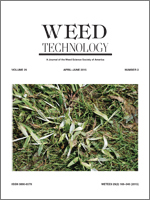Intercropping cantaloupe and cotton can improve grower profits over traditional monoculture practices because crops share resources and production costs. However, developing effective programs to control weeds with herbicides that are safe to both crops can be challenging. Research was conducted to (1) identify herbicide systems to manage Palmer amaranth in cantaloupe–cotton intercropping production while minimizing crop injury, and (2) determine the profitability of cantaloupe–cotton intercropping. Ethalfluralin applied preplant did not injure cantaloupe or cotton, but Palmer amaranth was not controlled. The addition of fomesafen preplant improved Palmer amaranth control to at least 92% without injuring cotton, but cantaloupe necrosis and chlorosis of up to 20% was recorded. Halosulfuron-methyl was safely applied over cantaloupe, but its residual activity reduced cotton growth by 12% at 4 wk after planting; halosulfuron-methyl did not improve Palmer amaranth control beyond that noted with ethalfluralin plus fomesafen preplant. Intercropping systems that controlled Palmer amaranth at least 92% produced cantaloupe yields (25,760 to 25,890 fruit ha−1) similar to the weed-free monoculture system (24,120 fruit ha−1) but produced lint cotton yields that were 170 to 275 kg ha−1 less than the weed-free monoculture cotton system. Although cotton production was less in the intercropping system, the returns over variable costs with intercropping systems ($21,670 to 21,920 ha−1) exceeded those of cantaloupe monoculture ($18,070 ha−1) or cotton monoculture ($1,890 to $1,955 ha−1), as long as Palmer amaranth was controlled. Intercropping cantaloupe and cotton is an effective approach to share land resources and production inputs as well as to improve grower profitability and is being rapidly adopted by Georgia growers.
Nomenclature: Ethalfluralin; fomesafen; halosulfuron-methyl; Palmer amaranth, Amaranthus palmeri S. Wats.; cantaloupe, Cucumis melo L.; cotton, Gossypium hirsutum L.
El sembrar melón cantaloupe y algodón en forma intercalada puede mejorar las ganancias de los productores, en comparación con las prácticas tradicionales de monocultivo, porque los cultivos comparten recursos y los costos de producción. Sin embargo, el desarrollo de programas efectivos de control de malezas con herbicidas que son seguros para ambos cultivos puede ser un reto difícil. Se realizó una investigación para (1) identificar sistemas de herbicidas para el manejo de Amaranthus palmeri en producción intercalada de cantaloupe-algodón minimizando el daño al cultivo, y (2) determinar la rentabilidad del cultivo intercalado de cantaloupe-algodón. Ethalfluralin aplicado en pre-siembra no dañó al cantaloupe o al algodón, pero A. palmeri no fue controlado. El agregar fomesafen en pre-siembra aumentó el control de A. palmeri a al menos 92% sin dañar el algodón, pero en cantaloupe se registró necrosis y clorosis hasta 20%. Halosulfuron-methyl fue seguro aplicado sobre cantaloupe, pero su actividad residual redujo el crecimiento del algodón en 12% a 4 semanas después de la siembra. Halosulfuron-methyl no mejoró el control de A. palmeri más allá del control notado con ethalfluralin más fomesafen en pre-siembra. Los sistemas intercalados que controlaron A. palmeri en al menos 92% produjeron rendimientos de cantaloupe (25,760 a 25,890 frutos ha−1) similares al sistema de monocultivo libre de malezas (24,120 frutos ha−1), pero produjeron rendimientos de fibra de algodón que fueron 17





